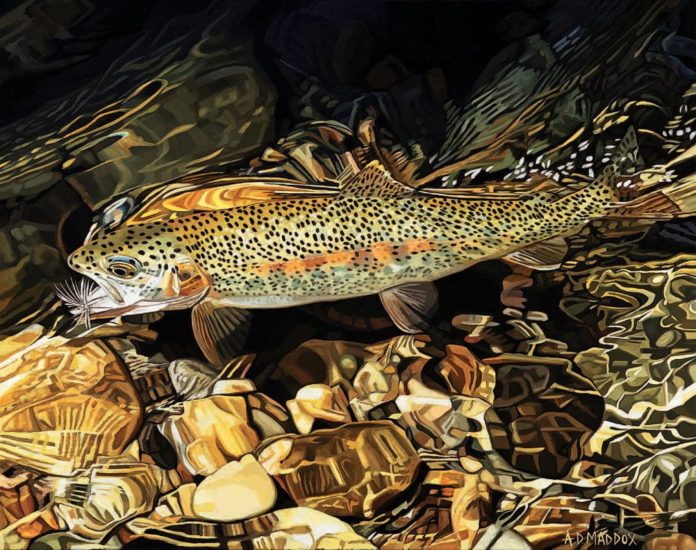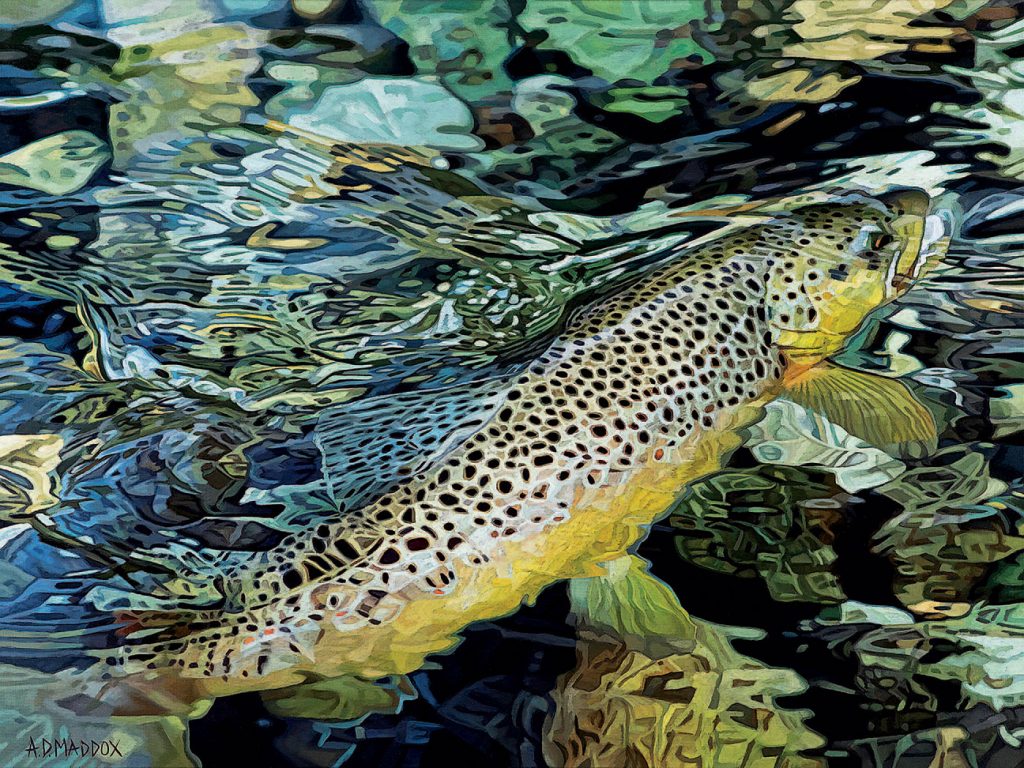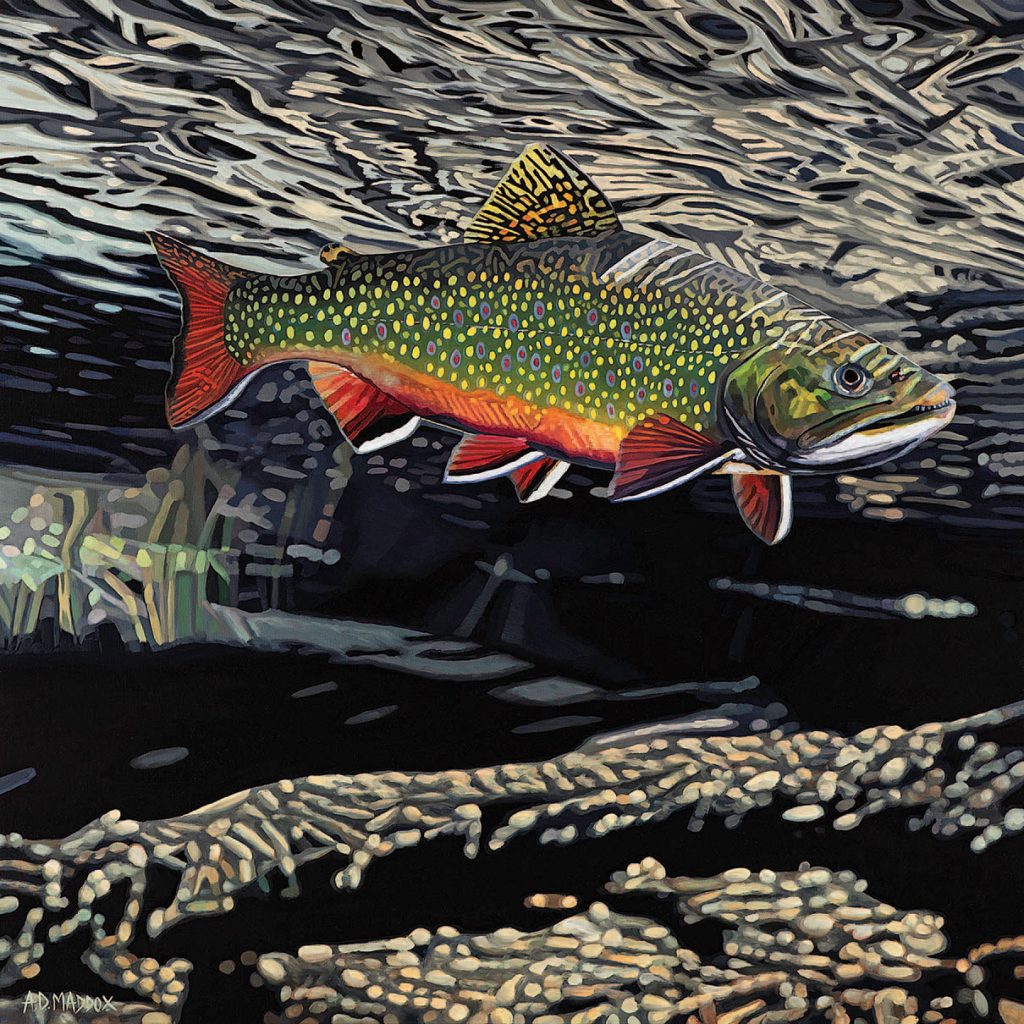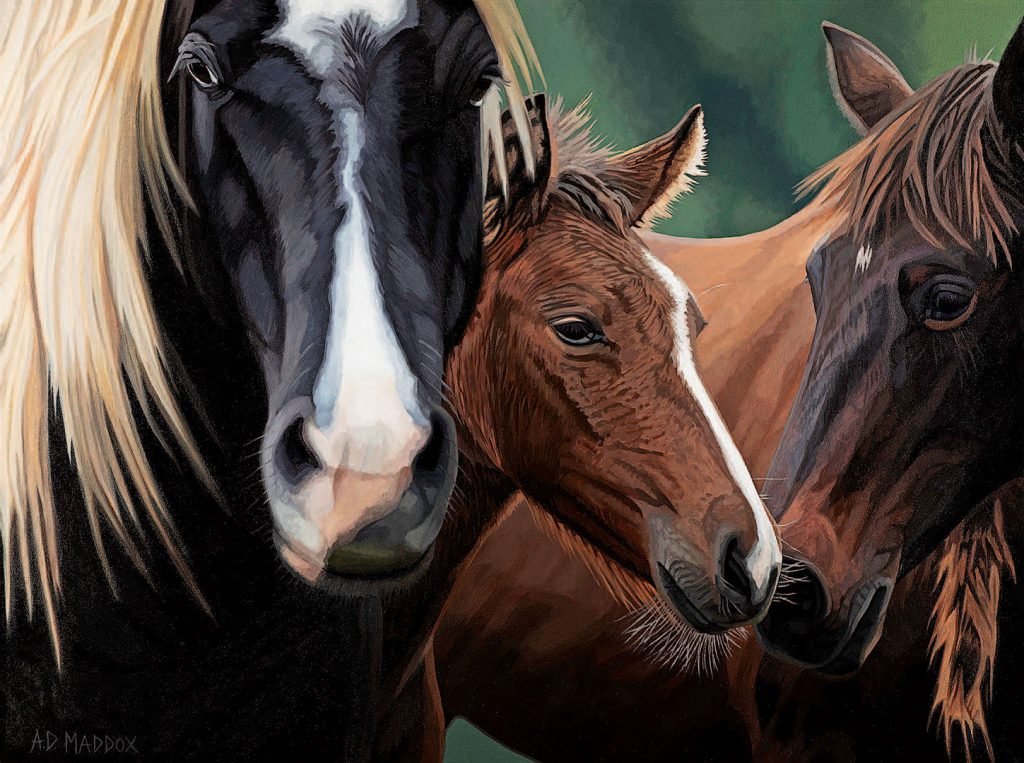We caught up with painter AD Maddox at her place in Montana and talked about art, fish, and how she reels them in on canvas.
Talking with painter AD Maddox is like jumping on a motorcycle and gunning it. Which is something Amelia Drane (“Drane is an old family name”) Maddox has been known to do. Back in the days when she was painting denim and “bug guts” — and deciding to go by AD because it’s male-sounding and men make more money than women in art — Ducati used a photograph of her on one of its bikes wearing her flame-painted jeans, blond hair seemingly blowing in the wind. Pretty wow.
She’s still wowing people. But these days it’s more about her art, which has evolved substantially. You’ll find her paintings in some of her favorite places in the West: Jackson Hole, Wyoming, and Livingston, Montana — two great locations where she indulges her passions for fly-fishing and mustang-chasing.
Working in Livingston out of a commercial building where she has a gallery out front — her 3,500-square-foot “playpen” — she’s busy with a trout series. “I work with a guide exclusively who catches the fish and holds them for me to photograph,” Maddox says. When it’s time to paint, she repairs to her studio space.
“The only thing that matters is getting it done — finishing cycles of action so attention isn’t dispersed, it narrows confusion and allows focus. The single most important ingredient is concentration. It takes an extreme amount of concentration.”
And, surprisingly, it takes an absence of natural light.
“Where I paint, the walls are literally black,” Maddox says. “Everything has to be blacked-out, I wear black — no reflections — so I can get the color right. It’s crazy how much reflection can mess with your eyes when you’re trying to do color.” She has a special lighting system so she can paint at any hour of the day. “It’s very specific as to the temperature of the bulbs: 5,000 Kelvin at a specific angle to the art overhead. I have to make sure my lighting is perfect. It’s very intense and involved.”
As is Maddox, who says her meticulous approach is necessary in “value painting,” which focuses more on the color group and varies from dark to light to pull off the photorealism of her oversize works. “The work is so detailed that the workload of a 30-by-40-inch canvas seems double its size. The biggest pieces are 3 by 4 feet, but I do some 4 by 6 commissions.”
You might say she’s capturing really big fish.
We caught up with Maddox at her place in Montana and talked about art, fish, and how she reels them in on canvas.
Cowboys & Indians: After a lot of traveling, you settled in the West. Why?
AD Maddox: Jackson Hole was a place my parents took us kids when we were younger; it was a family vacation spot. I learned how to ski there when I was 10. It was in my diary at 12 about how touched I was by this magical place. When I was 20 or 21, I made a decision to move to Jackson. In my 20s, I made my mark working with a company on the square doing T-shirts and painting clothing. I was a cocktail waitress then and met a lot of tourists. Went back to school in Denver in computer art, but I was confused working with the computer. I stayed in Denver for three years or so and then made this big push to go back to Jackson Hole. That’s when I really found my path. I could think when I was in Jackson. My head got clear. It’s not that open now, but back then there was lots of space. Within a year I was in a major gallery. All the while in Denver, I was painting Western horses and cowboys and doing trunk shows in Santa Fe selling my art. After some years in Jackson Hole, I moved to Livingston, Montana, three years ago. It’s a very creative and inspiring community. A lot of writers live here.
C&I: You’re known for your fish paintings, and Jackson Hole is a great base for fly-fishing. Tell us about your first fishing trip.
Maddox: I grew up fishing, but it was for bass and with the family. I learned fly-fishing in 2000 or 2001. My dad had purchased a vacation home and took me down to Yellowstone River. He put a rod in my hand and taught me how to fly-fish. Initially it was uncomfortable and difficult to cast, but I took to it very quickly. The first couple times the fly was everywhere but the water. I needed to catch the trout to bring them up to paint. I was already painting them and selling them. Needed more information than the photos I had to paint from. It was something new and exciting that I’d never done. Integrating this whole world I was creating: photographing, painting, fishing. I love to experience new things, especially with my father, who is 76 and still an avid fly fisherman and hunter.
C&I: When and where did you first realize how visually evocative fly-fishing and trout are? What did you see?
Maddox: In 1998 a gallery owner made a suggestion for me to paint trout as a possible motif for the gallery, so I got some visuals to be able to paint them. The first piece sold in 20 minutes for $1,000. I was 28 and I thought, Wow, this is successful. I wanted to paint and make money to be able to do what I love forever. I had been trying to pay my rent and my credit card bills working at a hospital in sports medicine, getting paid a very small hourly wage and slaving hard. So there was the money that could be earned. But then there were the fish themselves. You don’t see how astonishing they are unless you bring them to the surface. Rainbow. Brown. Brook. Cutthroat. They are so electric in color. And they vary in their colors. You’d never know unless you brought them out of the water. I was bringing some hidden beautiful creatures from the riverbed and making them visible. The different color combinations blew me away. Then I started learning about them. Not all rainbow have the same number of spots on their fins. Depending on the river, and what vegetation is around, the coloration varies. I saw how trout were not fixed in their color. The cutthroat has a red slash on its gill, which is where it gets its name. I learned the prominent features and then the variations. I found so much freedom in painting them.
C&I: Your work uniquely captures water. How do you visually convey the liquid, the movement, the light?
Maddox: That’s an art form in itself to bring to canvas. When I started doing the fish, I was doing portraits with someone holding them, and I would zoom in on the head. I would find a composition I thought was aesthetic. Then I worked with some photos taken by [photographer and fishing guide] Tom Montgomery that he would give me to work from. Some were in the water. So then comes the interpretation of the water. I’ve had so much feedback about the way I render water. I didn’t know how I did it — it was just my artistic interpretation. I slowly but surely became known for painting water like no one’s ever done before with these trout. Then I started posing the trout in the water. It has evolved. I don’t like doing portraits anymore. The fish squeak when you have them out of the water; they squawk like a chicken. It causes me pain to inflict any distress. So now the fish stay on the line in the water close to the surface so I can see the brilliant color coming through. My guide holds them for me in the water and I move around to get the perspective I need. The trout aren’t deprived and aren’t hurt. They are happy on the line. It’s the least amount of impact to the fish.
C&I: You’re an outdoorswoman and an artist. What’s the balance?
Maddox: My main love in life is painting. In the summer, I’m photographing; in the fall, I’m back at the easel painting every day. I’m working on the balance of being able to go out and breathe. There’s another job of living a good clean life outside of the studio. I have to keep living a great life every day and doing things right to be able to concentrate on the easel. You have to keep your hands clean, keep your ethics in order. You can’t go do crazy things and expect to perform at a high level. You have to be a good person.
Visit AD Maddox online at admaddox.com. See more of her art and read about her mustang paintings here.
From our November/December 2021 issue
Photography: (All images) courtesy AD Maddox
Cover image: Boulder River Rainbow
Credit: Source link



































